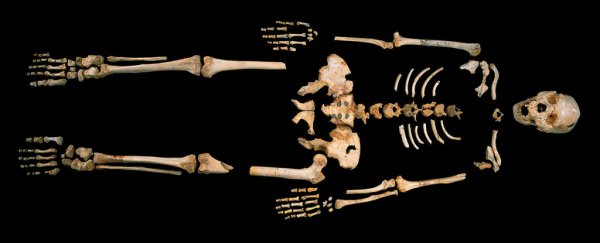Scientists have sequenced the oldest human DNA ever, extracted from 430,000-year-old samples of fossilised tooth and a thigh bones, found in Spain's Sima de los Huesos, which translates to "pit of bones".
In doing so, the team from Germany has found evidence that the ancient ancestors of modern humans must have split from the ancestors of Neanderthals hundreds of thousands of years earlier than we thought, which means it might be time for us to redraw the human family tree.
Located in the Cueva Mayor-Cueva del Silo cave system in north-central Spain, the Sima de los Huesos archaeological site contains the largest and oldest collection of human remains ever discovered, with more than 6,500 fossilised bone fragments - including over 500 teeth alone - from at least 28 individual hominins having been uncovered so far.
With remains dating back to 430,000 years ago, the famous "pit of bones" is finally allowing scientists to reconstruct the human family tree far beyond the past 100,000 years, and in doing so, have brought into question some long-held assumptions about how our early ancestors first came to be.
"It's fascinating and keeps us all on our toes trying to make sense of it all," palaeoanthropologist Chris Stringer from the Natural History Museum in London, who wasn't involved in the research, told Nature Magazine. "Instead of just being stuck with trying to resolve the last 100,000 years, we can really start to put some dates from DNA further down the human tree."
Until recently, the bones found in Sima de los Huesos were attributed to the early ancestors of Neanderthals, which evolved around 100,000 years earlier than the Neanderthals.
But a 2013 Nature study sequenced the mitochondrial genome of a femur found in the pit, which confirmed that the owner was more closely related to the Denisovans - an extinct species of human whose remains had previously been found thousands of kilometres away in Siberia - than the Neanderthals.
This discovery had two significant implications: at least one individual buried in the Sima de los Huesos site was a) not directly related to Neanderthals, and b) was instead directly related to the Denisovans, but existed hundreds of thousands of years earlier than the Denisovans themselves.
So knowing that, who were these Sima hominins exactly, and what do they mean for our understanding of human evolution?
Those questions have troubled researchers for years, because while their bones show some similarities to those of Neanderthals, they also appear to be connected to those of ancient humans too.
Ewen Callaway from Nature Magazine explains:
"The Sima hominin skulls have the beginnings of a prominent brow ridge, as well as other traits typical of Neanderthals. But other features, and uncertainties around their age - some studies put them at 600,000 years old, others closer to 400,000 - convinced many researchers that they might instead belong to an older species known as Homo heidelbergensis."
A team led by Matthias Meyer from the Max Planck Institute for Evolutionary Anthropology in Germany decided to put an end to the confusion (or at least alleviate it slightly) by sequencing the nuclear and mitochondrial DNA taken from five bone samples (most likely from different individuals) found in Sima de los Huesos.
Reporting in Nature today, the team says that while most of the 430,000-year-old DNA was understandably degraded beyond recognition, the tiny parts of the genome they were able to retrieve and decode revealed that these particular individuals were actually early Neanderthals.
So we've got one individual in the pit that's directly related to the Denisovans - as evidenced by the 2013 study - and a handful of individuals from the study published today that are related to Neanderthals, and they're both dated to the same moment in history.
What does this tell us? That the two groups - the Neanderthals and the Denisovans - must have diverged from their common ancestor by 430,000 years ago, and this is way earlier than anyone expected them to have split.
Knowing this has big implications for our own timeline, says Colin Barras at New Scientist:
"We know that Denisovans and Neanderthals shared a common ancestor that had split from our modern human lineage. In light of the new nuclear DNA evidence, Meyer's team suggests this split might have happened as early as 765,000 years ago. Previous DNA studies had dated this split to just 315,000 to 540,000 years ago, says Katerina Harvati-Papatheodorou at the University of Tubingen in Germany."
Interestingly, that 765,000 date for the Denisovan- Neanderthal split could actually point us in the right direction to find our earliest common ancestor. As Barras explains, researchers have hypothesised that modern humans, Neanderthals, and Denisovans all evolved from an ancient hominin called Homo heidelbergensis, but we have evidence to suggest that this species didn't evolve until 700,000 years ago.
Instead, we should be looking at another species called Homo antecessor - which evolved much earlier than H. heidelbergensis - as being our common ancestor instead.
This means it's time to start looking for a population of human ancestors that lived between 700,000 to 900,000 years ago to find out where we came from, palaeoanthropologist at University College London, Maria Martinón-Torres told Callaway at Nature Magazine: "She thinks that Homo antecessor, known from 900,000-year-old remains from Spain, is the strongest candidate for the common ancestor, if such specimens can be found in Africa or the Middle East."
And so, with more knowledge about our incredibly complicated family tree comes less certainty, but that's the beauty of the scientific method at work. Now the hunt is on to find remains of H. antecessor that could reveal it to be the true common ancestor of modern humans, Neanderthals, and Denisovans, and that would be a pretty incredible thing to see within our lifetime.
